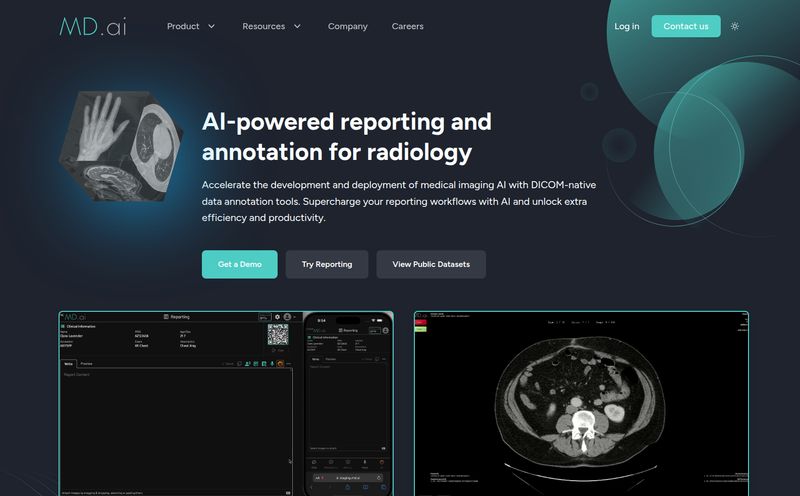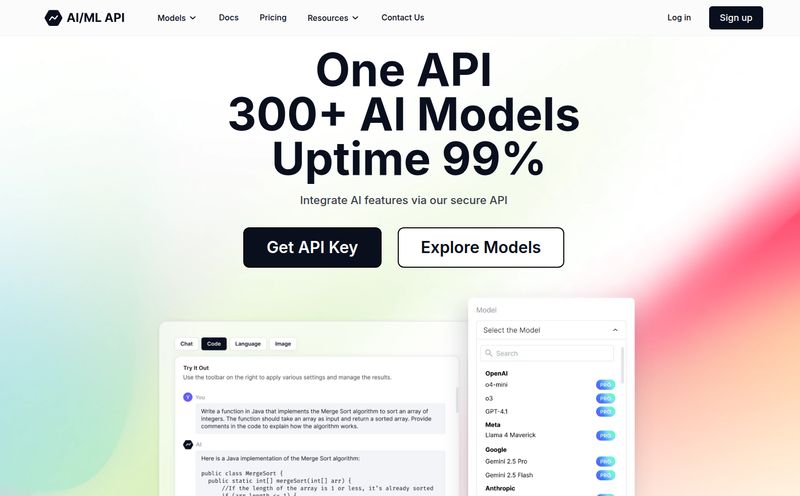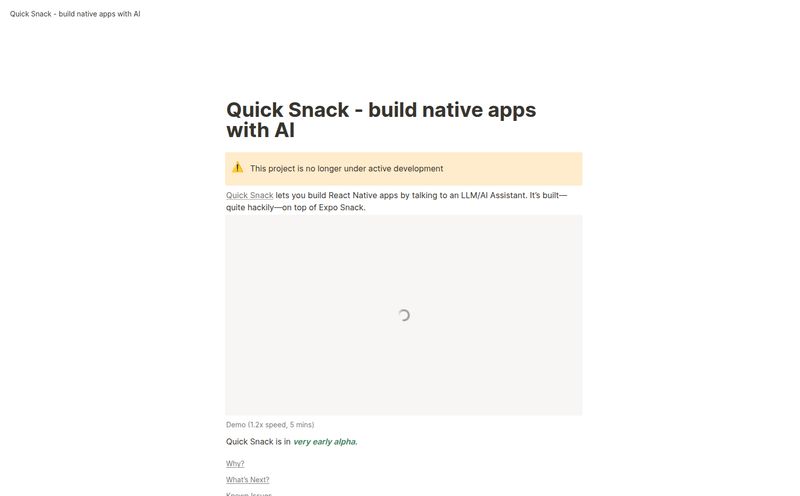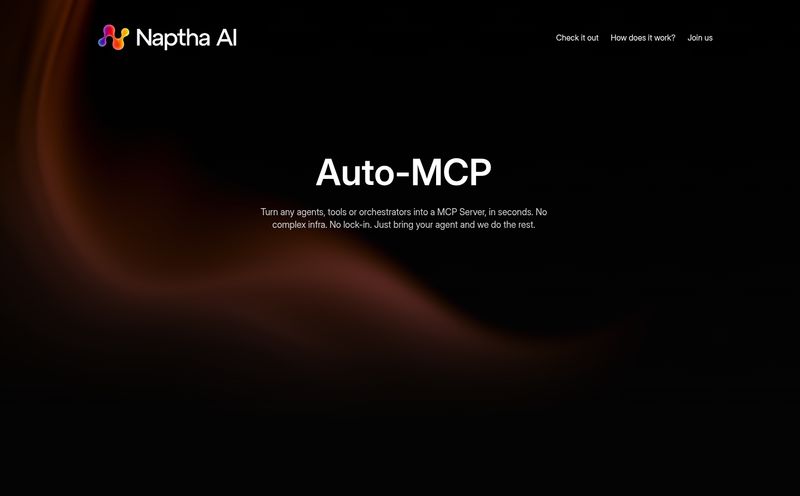I’ve been in the SEO and web development game for a long time. Long enough to remember when slicing up a Photoshop PSD file was considered cutting-edge. We’d spend hours, sometimes days, meticulously converting a static design into functional HTML and CSS. It was tedious. It was soul-crushing. And it was just… the way things were done.
Then came the wave of AI tools, all promising to automate the boring stuff. We've seen a lot of them, right? Some are brilliant, others are, well, less than brilliant. So when I stumbled upon a new tool called screenshot2code.com, my curiosity was piqued. The promise is simple, but incredibly potent: take a screenshot of a user interface and have AI spit out the HTML code.
It sounds like magic. Digital alchemy. But in my experience, when something sounds too good to be true, it often is. So, let's take a closer, no-fluff look at what this tool is, what it promises, and whether it’s about to become an indispensable part of our toolkit.

Visit screenshot2code.com
So What Exactly is screenshot2code?
At its core, screenshot2code is a web-based platform designed to do one thing: convert a UI screenshot into code. You upload an image of a website, an app interface, or even a rough design you sketched on a napkin (though results may vary on that one), and its engine gets to work.
The secret sauce here is the use of the GPT-Vision API from OpenAI. This isn’t your old-school OCR trying to guess what text is. This is a multimodal AI that can literally see and interpret the structure, layout, colors, and components of an image. It sees a blue button with white text and understands it needs to generate a <button> tag with the appropriate CSS. It's a translator for the visual language of design.
The platform also claims to offer a live preview and the ability to edit the generated code on the fly. This is huge. It means it’s not just a black box; it's an interactive workspace.
The Potential Game-Changing Features
Now, I say “potential” because, full disclosure, the site is currently in a “COMING SOON” state. It’s like we’ve been invited to the restaurant’s soft opening, but we can only look at the menu for now. But oh, what a menu it is.
The Magic of Live Preview and Editing
The ability to see the HTML render in real-time as the AI generates it is a fantastic concept. No more downloading a zip file, unzipping it, opening it in your code editor, and then running it on a local server just to see if it worked. This immediate feedback loop could be a massive time-saver. Furthermore, the promise of on-the-fly editing is what really gets my attention. AI is a great starting point, but it's rarely the finish line. Being able to quickly tweak the generated code—change a class name, adjust a margin, fix a typo—right there in the browser is the bridge between AI efficiency and human-quality craftsmanship.
Think about it. You could use it for rapid prototyping, getting a baseline structure for a new landing page in minutes, not hours. For a designer like me who can dabble in code, it’s a way to bring a vision to life without getting bogged down in boilerplate stuff.
A Healthy Dose of Reality
Okay, let's pull back from the hype train for a second. As exciting as this all sounds, we need to be realistic. I've seen enough AI tools to know their limitations.
The AI Isn't Perfect (and That's Okay)
The output quality will be entirely dependent on two things: the quality of your screenshot and the current capabilities of the GPT-Vision API. A blurry, low-resolution screenshot will likely produce a mess of code. It’s the classic GIGO principle: Garbage In, Garbage Out. Even with a perfect screenshot, the AI might make some… interesting choices. It might use divs for everything, or generate overly complex CSS. I fully expect that the initial output will need a human touch to make it semantic, accessible, and truly production-ready. Think of it as a very talented junior developer who is super fast but needs a bit of guidance.
The Elephant in the Room
The site is, as of this writing, a simple landing page that says “COMING SOON.” When I tried to find a pricing page, I was met with a classic 404 error. It’s a project in its infancy. And honestly, the current landing page is a bit quirky. It has these random footer links for a “Password Strength Checker” and “When is ovulation,” which tells me it's probably a template or a parked domain waiting for its real content. It’s a bit funny and adds a touch of ‘this is a real project in the works’ charm, not some slick, corporate vaporware.
What About the Price Tag?
This is the million-dollar question, isn't it? Since the pricing page doesn’t exist yet, we can only speculate. I could see a few potential models working here:
- A Freemium Model: Maybe 3-5 free conversions a month, with a subscription for unlimited use. This is a popular route for dev tools.
- Pay-Per-Conversion: A credit-based system where you buy a pack of conversions. Good for occasional users.
- Tiered Subscriptions: Different plans based on usage, features (like team collaboration), or API access.
My hope is that they offer some kind of free tier so people can test the waters and see if the tool’s output fits their workflow. We'll have to wait and see.
Who Is a Tool Like This Actually For?
I can see a few groups getting really excited about this.
First, frontend developers looking to speed up their initial build process. It's a great way to get the skeleton of a page built quickly, freeing you up to focus on the more complex JavaScript and interactions. Second, UI/UX designers who want to create quick, interactive mockups without needing to be coding wizards. Third, marketers and entrepreneurs who need to throw together a quick landing page for a campaign without waiting on a dev team. It democratizes the process a little bit.
Frequently Asked Questions
- What is screenshot2code.com?
- screenshot2code.com is an upcoming online tool that uses the GPT-Vision AI to convert screenshots of user interfaces (UIs) into functional HTML and CSS code, with a planned live preview and editing feature.
- How does screenshot to HTML conversion work?
- It uses a multimodal AI model (GPT-Vision) that can visually analyze an image. The AI identifies different elements like buttons, text blocks, images, and containers, and then generates the corresponding HTML and CSS code to replicate that structure and style.
- Is screenshot2code free?
- The pricing information is not yet available as the site is still in its “COMING SOON” phase. It's likely there will be a free tier or trial, with paid plans for heavier use, but this is just speculation.
- Will the generated code be ready for production?
- Probably not immediately. While it can create a very strong starting point, AI-generated code usually requires manual review and refinement to ensure it meets best practices for semantics, accessibility, and performance. Think of it as a first draft, not a final product.
- What is GPT-Vision?
- GPT-Vision, or GPT-4V, is a version of OpenAI's powerful AI model that can accept and process image inputs. It can 'see' and 'understand' images, allowing it to perform tasks like describing what's in a picture or, in this case, translating a visual design into code.
- Are there any alternatives to screenshot2code?
- Yes, the idea of turning designs into code is a hot space. Some existing tools attempt this, and features are being built into platforms like Figma. Big companies are also experimenting with internal tools that do similar things. The key differentiator for screenshot2code will be its ease of use and the quality of its output from the GPT-Vision API.
My Final Thoughts
So, is screenshot2code.com the holy grail? Not yet. It's an exciting promise wrapped in a “coming soon” page. But the concept itself—leveraging powerful vision AI to bridge the gap between design and development—is absolutely the direction we're headed. I’m genuinely excited to see this thing launch.
Tools like this won't replace good developers. They empower them. They take the robotic, repetitive part of our jobs and automate it, letting us focus on the creative, problem-solving aspects that we actually enjoy. I’ll be keeping my eye on this one, and you should too. Let's just hope they fix those footer links before the big launch.



